
Erythranthe cardinalis, the scarlet monkeyflower, is a flowering perennial in the family Phrymaceae. Together with other species in Mimulus section Erythranthe, it serves as a model system for studying pollinator-based reproductive isolation. It was formerly known as Mimulus cardinalis.
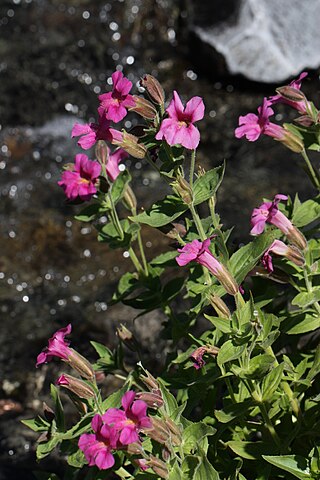
Erythranthe lewisii is a perennial plant in the family Phrymaceae. It is named in honor of explorer Meriwether Lewis. Together with other species in Erythranthe, it serves as a model system for studying pollinator-based reproductive isolation. It was formerly known as Mimulus lewisii.

Diplacus douglasii is a species of monkeyflower known by the common names brownies and purple mouse ears. It is native to the mountains and foothills of California and Oregon, where it is often found on serpentine soils. D. douglasii was first described in a published flora by George Bentham, an English botanist who was considered "the premier systematic botanist of the nineteenth century,." It was later described by Asa Gray, the father of North American botany.
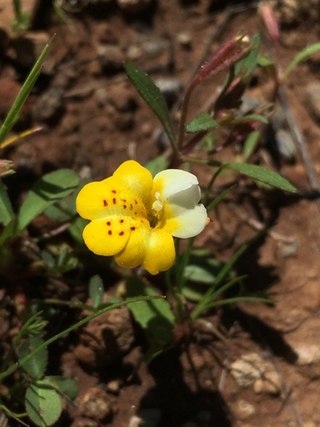
Erythranthe bicolor, the yellow and white monkeyflower, is a species of flowering plant in the lopseed family (Phrymaceae). It is endemic to California, United States. It was formerly known as Mimulus bicolor.
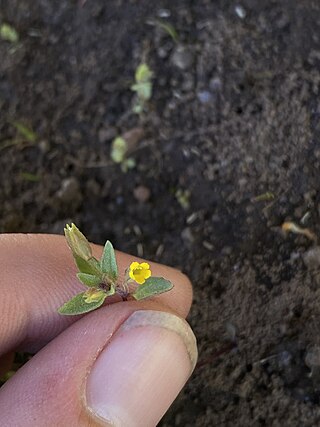
Erythranthe breviflora is a species of monkeyflower known by the common name shortflower monkeyflower. It is native to western North America from British Columbia to Wyoming to the Modoc Plateau and northern Sierra Nevada in California. It grows in moist areas in several types of habitat. It was formerly known as Mimulus breviflorus.
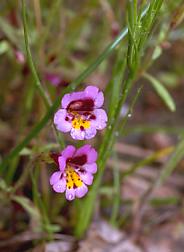
Erythranthe filicaulis, known by the common name slender-stemmed monkeyflower, is a species of monkeyflower. It was formerly known as Mimulus filicaulis.

Erythranthe floribunda is a species of monkeyflower known by the common name many-flowered monkeyflower. It is native to western North America from western Canada to California and northern Mexico, to the Rocky Mountains. It grows in many types of habitat, especially moist areas. It was formerly known as Mimulus floribundus.
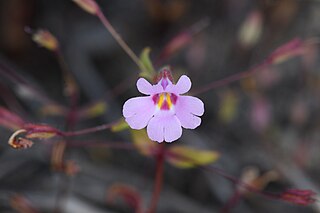
Erythranthe gracilipes is an uncommon species of monkeyflower known by the common name slenderstalk monkeyflower. It was formerly known as Mimulus gracilipes.
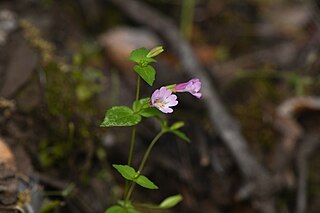
Erythranthe inconspicua, synonym Mimulus inconspicuus, is an uncommon species of monkeyflower known by the common name smallflower monkeyflower.

Diplacus jepsonii, formerly classified as Mimulus nanus var. jepsonii, is a species of monkeyflower known by the common name Jepson's monkeyflower.
Erythranthe inflatula, synonyms Mimulus inflatulus and Mimulus evanescens, is a rare species of monkeyflower known by the common name disappearing monkeyflower. It is native to the western United States, where it is known from about ten locations in and around the Great Basin within the states of Idaho, Oregon, and California; it is also found in Nevada. Specimens of the plant had been catalogued as Mimulus breviflorus, but on further examination it was evident that they were a separate, unclassified species; this was described to science in 1995. It is thought that the plant may have evolved via hybridization between Erythranthe breviflora and Erythranthe latidens, or that it evolved from E. latidens and then into E. breviflora.

Diplacus mephiticus is a species of monkeyflower known by the common names skunky monkeyflower and foul odor monkeyflower. It was formerly known as Mimulus mephiticus.
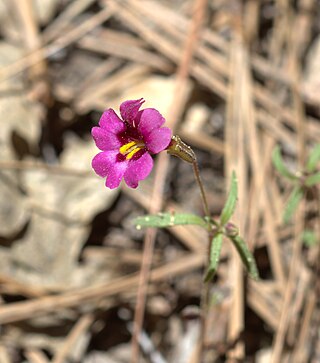
Erythranthe palmeri is a species of monkeyflower known by the common name Palmer's monkeyflower. It was formerly known as Mimulus palmeri.
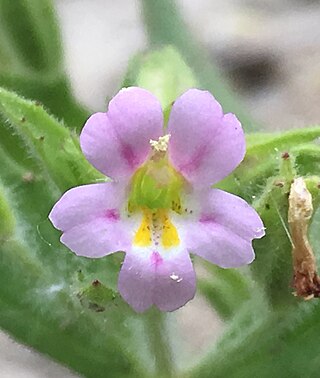
Erythranthe parishii is a species of monkeyflower known by the common name Parish's monkeyflower. It was formerly known as Mimulus parishii.

Diplacus pictus is a species of monkeyflower known by the common name calico monkeyflower.

Erythranthe shevockii is a rare species of monkeyflower known by the common name Kelso Creek monkeyflower. It was formerly known as Mimulus shevockii.

Diplacus whitneyi is a species of monkeyflower known by the common name Harlequin monkeyflower. It was formerly known as Mimulus lewisii. It is also known as Diplacus bicolor.

Erythranthe, the monkey-flowers and musk-flowers, is a diverse plant genus with more than 120 members in the family Phrymaceae. Erythranthe was originally described as a separate genus, then generally regarded as a section within the genus Mimulus, and recently returned to generic rank. Mimulus sect. Diplacus was segregated from Mimulus as a separate genus at the same time. Mimulus remains as a small genus of eastern North America and the Southern Hemisphere. Molecular data show Erythranthe and Diplacus to be distinct evolutionary lines that are distinct from Mimulus as strictly defined, although this nomenclature is controversial.

Erythranthe suksdorfii, with the common names Suksdorf's monkeyflower and miniature monkeyflower, is an annual flowering plant in the family Phrymaceae (Lopseed). It was formerly known as Mimulus suksdorfii. A specimen collected in Washington state in 1885 by the self-taught immigrant botanist Wilhelm Nikolaus Suksdorf was identified as a new species by Asa Gray in 1886, who named it in Suksdorf's honor. It can easily be misidentified with Erythranthe breviflora, which generally has elliptic leaves rather than the linear or oblong leaves found in E. suksdorfii.

Erythranthe norrisii, formerly Mimulus norrisii, also known as Kaweah monkeyflower, is a species of flowering plant. Kaweah monkeyflower is endemic to the Kaweah River watershed of California in North America and is considered a rare species. Most specimens are known from Sequoia National Park in Tulare County. According to the Flora of North America Association, Kaweah monkeyflower grows in "steep marble outcrops in soil pockets, moss covered marble and quartzite ledges, cracks, fractures, weathered faces, chamise chaparral or blue oak woodlands."



















